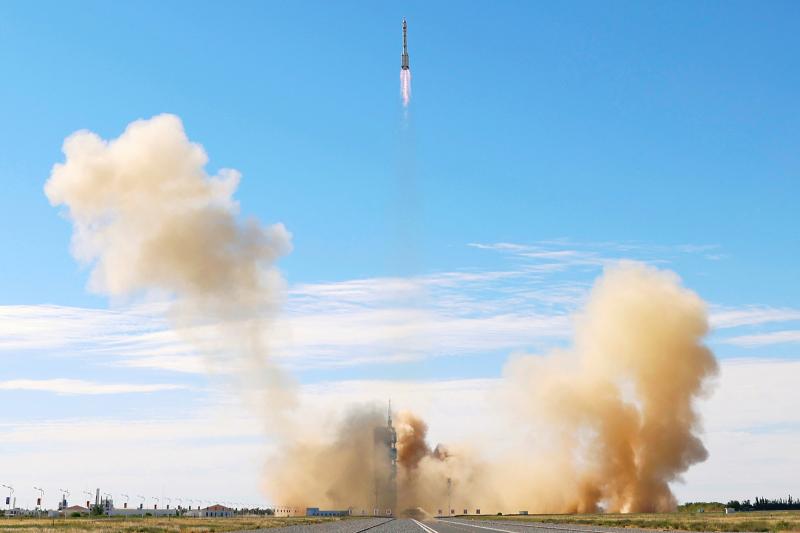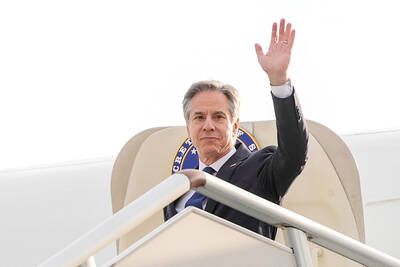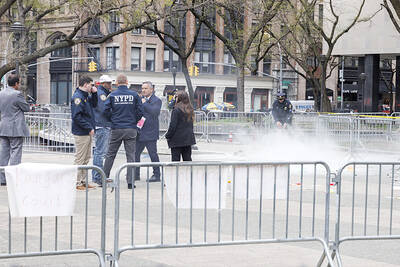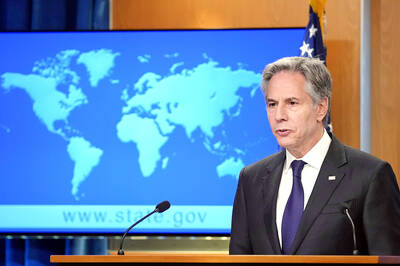The first astronauts for China’s new space station yesterday blasted off for the country’s longest crewed mission to date.
The three astronauts launched on a Long March-2F rocket for the Tiangong station — where they are to spend three months — in a much-anticipated blastoff broadcast live on state TV.
Liftoff happened at 9:22am from the Jiuquan Satellite Launch Center in China’s Gobi Desert, with the rocket rising in clouds of smoke against a blue sky.

Photo: Reuters
After about 10 minutes it reached orbit altitude and the spacecraft separated from the rocket to loud applause in the control room among rows of blue-suited engineers.
China Central Television showed a live feed from inside the spacecraft, with the three astronauts lifting their visors, and one smiling and waving at the camera.
Another floated a pen just above his lap as he browsed the flight manual.
Cameras outside the craft broadcast live images of the Earth.
“According to reports from the Beijing aerospace control center, the Long March-2F rocket has sent the Shenzhou-12 manned spacecraft to the preset orbit,” Jiuquan Satellite Launch Center director Zhang Zhifen (張志芬) said. “The solar panels unfolded successfully and now we declare the Shenzhou-12 launch a complete success.”
At a ceremony before blastoff, the three astronauts, already wearing their space suits, greeted a crowd of supporters and space workers, who sang Without the Chinese Communist Party, there would be no new China.
The mission’s commander is Nie Haisheng (聶海勝), a pilot in the People’s Liberation Army Air Force who has already participated in two space missions.
The two other members are also members of the military.
Their spacecraft was to dock with the Tianhe main section of the space station, which was placed in orbit on April 29, possibly as soon as six hours after liftoff.
The module has separate living spaces for each of them, a “space treadmill” and bike for exercise, and a communications center for e-mails and video calls with ground control.
It is China’s first crewed mission in nearly five years.
Huang Weifen (黃偉芬) of the China Manned Space Program said that the astronauts would perform two spacewalks during the mission, both lasting six or seven hours.
The trio would wear newly developed spacewalk spacesuits, Huang said.
To prepare for the mission, the crew underwent more than 6,000 hours of training, including hundreds of underwater somersaults wearing full space gear.
The China National Space Administration is planning 11 launches through the end of next year, including three more crewed missions to deliver two lab modules to expand the 70 tonne station, and supplies and crew members.
China has said it would be open to international collaboration on its space station, although it has yet to give specific details,
Zhou Jianping (周建平), chief designer at the space program, said that “foreign astronauts are certainly going to enter the Chinese space station one day.”
“There are a number of countries that have expressed a desire to do that and we will be open to that in future,” Zhou said.
Beijing in March said that it was also planning to collaborate with Russia to build a separate lunar space station.

‘IN A DIFFERENT PLACE’: The envoy first visited Shanghai, where he attended a Chinese basketball playoff match, and is to meet top officials in Beijing tomorrow US Secretary of State Antony Blinken yesterday arrived in China on his second visit in a year as the US ramps up pressure on its rival over its support for Russia while also seeking to manage tensions with Beijing. The US diplomat tomorrow is to meet China’s top brass in Beijing, where he is also expected to plead for restraint as Taiwan inaugurates president-elect William Lai (賴清德), and to raise US concerns on Chinese trade practices. However, Blinken is also seeking to stabilize ties, with tensions between the world’s two largest economies easing since his previous visit in June last year. At the
Nearly half of China’s major cities are suffering “moderate to severe” levels of subsidence, putting millions of people at risk of flooding, especially as sea levels rise, according to a study of nationwide satellite data released yesterday. The authors of the paper, published by the journal Science, found that 45 percent of China’s urban land was sinking faster than 3mm per year, with 16 percent at more than 10mm per year, driven not only by declining water tables, but also the sheer weight of the built environment. With China’s urban population already in excess of 900 million people, “even a small portion

UNSETTLING IMAGES: The scene took place in front of TV crews covering the Trump trial, with a CNN anchor calling it an ‘emotional and unbelievably disturbing moment’ A man who doused himself in an accelerant and set himself on fire outside the courthouse where former US president Donald Trump is on trial has died, police said yesterday. The New York City Police Department (NYPD) said the man was declared dead by staff at an area hospital. The man was in Collect Pond Park at about 1:30pm on Friday when he took out pamphlets espousing conspiracy theories, tossed them around, then doused himself in an accelerant and set himself on fire, officials and witnesses said. A large number of police officers were nearby when it happened. Some officers and bystanders rushed

Beijing is continuing to commit genocide and crimes against humanity against Uyghurs and other Muslim minorities in its western Xinjiang province, U.S. Secretary of State Antony Blinken said in a report published on Monday, ahead of his planned visit to China this week. The State Department’s annual human rights report, which documents abuses recorded all over the world during the previous calendar year, repeated language from previous years on the treatment of Muslims in Xinjiang, but the publication raises the issue ahead of delicate talks, including on the war in Ukraine and global trade, between the top U.S. diplomat and Chinese